
Royal Worcester 'Golden Anniversary' Fine Bone China Porcelain Dinner Set
Royal Worcester 'Golden Anniversary' fine bone china porcelain partial dinner set, comprising;, 1 x teapot, 1 x gravy boat & saucer, 1 x large oval plate, 2 x oval plates, 2 x creamers, 2 x sugar bowls, 8 x shallow bowls, 8 x dinner plates, diameter 27 cm…

Royal Worcester Pink Rose Sugar & Cream Jug, signed M Hunt
Royal Worcester sugar and cream jug, painted with pink roses signed M Hunt circa 1932 for John Bates & Co Ltd Worcester house Christchurch (NZ)

Royal Worcester 3pce Fruit Teaset, Signed Leaman and J Smith
Royal Worcester 3pce teaset, painted with fruits teapot and sugar basin signed Leaman, cream jug signed J Smith sugar basin 11 cm diameter

Royal Worcester Fruit Painted Sugar Bowl by Freeman, 1957
Royal Worcester fruit painted sugar bowl by Freeman, fully painted exterior in the round with peaches and cherries on mossy ground, gilt enrichments. Signed and date coded for 1957. Diameter 9.5 cm.

Royal Worcester Fruit Painted Miniature Tea Service by Various Artists
A Royal Worcester fruit painted miniature tea service, comprising tea pot, lidded sugar bowl, cream jug and cup, saucer and plate. Finely painted with peaches etc. Signed by Roberts, Ayrton and others.

Royal Worcester 'Countess of Dudley' Sugar Bowl, Dated 1865
A Royal Worcester porcelain 'Countess of Dudley' service covered sugar bowl, dated 1865, the decoration by Thomas Scott Callowhill and James Callowhill, the jewelling and gilding by Samuel Ranford, Cup-shaped on three gilt lion's paw feet with a finialled…

Royal Worcester White Porcelain Dinner Service with Basketweave Birds
Royal Worcester white porcelain part dinner service decorated with basketweave figural birds on lids, 3 dinner plates, diameter 25.5 cm, 4 dessert plates, diameter 18 cm, 5 bowl, diameter 17.5 cm, 4 flat cup plates, diameter 15 cm, 3 tea cups, 1 pitcher,…
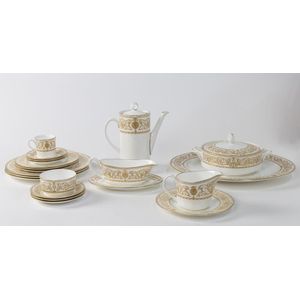
Royal Worcester 'Hyde Park' Service for Eight Place Settings
A comprehensive Royal Worcester 'Hyde Park' service for eight place settings, comprising dinner, entree, side plates, soup coupes, tea cups and coffee cans with associated saucers, coffee pot, creamer, sugar basin, two covered tureens, gravy boat and…
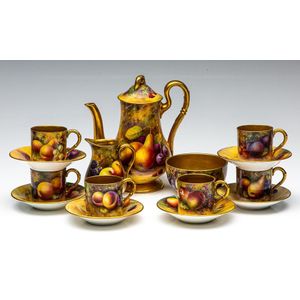
Royal Worcester Handpainted Gilded Coffee Suite
A handpainted and gilded Royal Worcester six person coffee suite Pieces from various artists, comprising 1 coffee pot, signed A. Shuck, 1 creamer, signed H. Price, 1 open sugar, signed T. Lockyer, 6 coffee cups, incl. Moseley, Townsend, Everett and Ayrton…
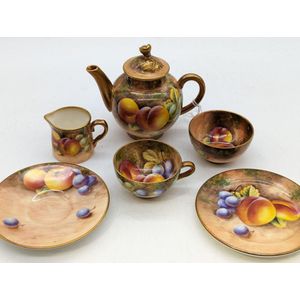
Signed Royal Worcester Miniature Fallen Fruit Teaset
Royal Worcester porcelain miniature teaset, signed, hand painted fallen fruit pattern comprising teapot, trio, creamer and sugar bowl teapot, height 8.6 cm, (some a/f)

Hand-painted Royal Worcester Miniature Fallen Fruit Teaset
Royal Worcester porcelain miniature teaset, signed, hand painted fallen fruit pattern comprising teapot, trio, creamer and sugar bowl (teapot, height 8.6 cm)

Royal Worcester Coffee Set with Tray & Accessories for Four
A Royal Worcester coffee service for four including tray, sugar bowl, teapot and others
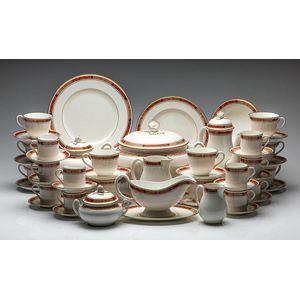
Royal Worcester 'Beaufort' Dinner Suite
An extensive Royal Worcester 'Beaufort' patterened dinner suite comprising: 10 dinner plates, 10 bowls, 1 crescent shaped platter, 1 serving platter, 1 large serving platter, 1 large tureen with extra lid, 5 bread and butter plates, 10 teacup and saucer…

Royal Worcester Roanoke Tea Set with Fluted Design
A Royal Worcester Roanoke tea set, comprising four trios, a sugar bowl, a creamer and two teapots of fluted design with loose posies of flowers, black backstamps underside, the teapots 14 cm high

Hand-painted Royal Worcester Fruit Miniature Tea Set
Three Royal Worcester fruit miniature tea wares all signed and hand painted with fruit decoration, comprising a coffee pot, teapot, and lidded sugar bowl.

Royal Worcester Hand-Painted Demitasse Coffee Set & Sugar Bowl
A Royal Worcester hand painted demitasse coffee duo, and sugar bowl by a. Shuck, diameter 9.5 cm bowl

Antique Royal Worcester Tea Set with Maple & Co Retailer
A Royal Worcester tea set, date code for 1917, retailed by Maple & Co, comprising eleven cups and saucers, eleven cake plates, a cream jug, a sugar bowl and a larger plate, all decorated in gold with urns and classical motifs on a white and pink ground,…

Palissy Royal Worcester Game Series Dinner & Tea Set
A Palissy of the Royal Worcester group 'Game Series' dinner and tea setting including: 8 dinner plates, 8 bread plates, 8 bowls, 8 trios, 1 oval serving platter, length 30 cm, 1 teapot, 1 creamer, 1 sugar pot

Gold Lace Royal Worcester Teaset
Vintage Royal Worcester 'Gold Lace' teaset including: 6 trios, cream jug, sugar bowl, and cake plate.

Royal Worcester 'Evesham' Dinnerware Set
A suite of Royal Worcester 'Evesham' dinner wares includes 8 lidded cups, 1 large ramekin, 1 medium ramekin, 6 small ramekins, 1 small gravy boat and saucer, 1 large gravy boat and saucer, 1 large tureen, 1 smaller tureen, 1 oval tureen, 1 rectangular…
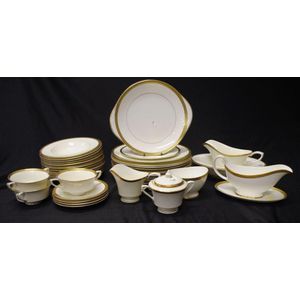
Royal Worcester Coventry Dinner Set
Part Royal Worcester 'Coventry' dinner set comprising 12 dinner plates, 12 bowls, one entree plate, three soup coups & four under plates, cake plate, serving bowl, lidded sugar pot, sugar bowl, two sauce boats and an under saucer

Royal Worcester 'Evesham' Cooking Set
A Royal Worcester 'Evesham' cooking suite including: one large tureen, diameter 25 cm, one medium sized tureen, two oval baking dishes, one sauce boat, one small finger bowl, three shell form dishes, one rectangular oven dish, one round baking dish, two…

Royal Worcester Evesham Porcelain Suite - 58 Pieces
A suite of Royal Worcester Evesham porcelain, comprising fourteen main plates, twelve soup bowls, eighteen entree plates, sixteen cake plates, four dessert bowls, four larger bowls, three mugs, fourteen tea cups and saucers, two egg coddlers, one large…
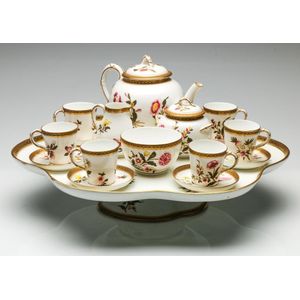
Gilt Rimmed Floral Tea Set for Six
Royal Worcester gilt rimmed and floral patterned tea service for six comprising of teapot, lazy susan, lidded sugar, sugar bowl, creamer, and six cup and saucer duos

Pair of Royal Worcester Mermaid Salt Dishes
Two Royal Worcester mermaid formed salt dishes one male and one female, height 10 cm, width 12 cm

Handpainted Fruit Miniature Tea/Coffee Set by Roberts
Royal Worcester miniature tea/coffee for two set comprising two cups,saucers, and plates, lidded sugar, creamer, teapot and coffee pot, restoration to coffee pot,all handpainted with fruit decoration and signed Roberts

Handpainted Fruit Tea Set by Royal Worcester
Royal Worcester miniature tea for two set comprising 2 cups and saucers one with broken handle, 1 plate, teapot, lidded sugar and creamer, all handpainted with fruit decoration, signed

Hand-painted Rose Royal Worcester Set
Royal Worcester cup, saucer, sugar & cream, all hand painted with roses

Cherub Salt with Shell by Royal Worcester
Royal Worcester blanc de chine salt, formed as a cherub holding a large shell

Royal Worcester Virginia Porcelain Dinner Service
Royal Worcester porcelain dinner service, in Virginia pattern, comprising eight dinner plates, eight entree plates, eight bread and butter plates, eight soup coupes with matching saucers, one gravy jug and matching saucer, two platters, two tureens, cream…

Royal Worcester Gold Lustre Coffee and Tea Set
A Royal Worcester gold lustre coffee and tea set, 8pcs mid 20th century comprising of: 1 x tea pot 1 x coffee pot 1 x milk jug 1 x sugar bowl 1 x small bowl 1 x salt shaker 1 x pepper shaker 1 x condiment jar

Royal Worcester 'Bernina' Dinner Set
Royal Worcester 'Bernina' dinner setting, Consists of, 1 x teapot, 1 x salad bowl, diameter 24 cm, 4 x egg coddlers, 6 x teacups + 6 x saucers, 1 x pin dish, diameter 11.5 cm, 6 x bread and butter plates, diameter 18.3 cm, 6 x fruit bowls, diameter 17 cm,…

Royal Worcester Blue Floral Creamer & Sugar Bowl Set
A Royal Worcester creamer & sugar bowl, white ground with blue floral design silver plate rim on bowl & lid of creamer with cane covered handle

Regency Dolphin Salt Cellars with Repair
Royal Worcester pair of Regency dolphin table salt cellars, height 11 cm, repair to one

Royal Worcester Rhapsody Collection: Tureen, Shakers, Pots, and More
A Royal Worcester 'Rhapsody' collection, includes a lidded tureen, two salt shakers, a pepper grinder, two lidded pots, oil & vinegar bottle
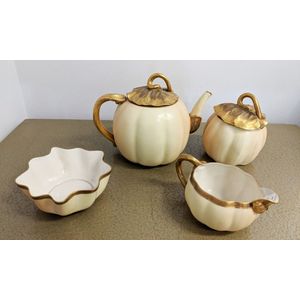
Royal Worcester Pumpkin Tea Set (1893-1895)
A Royal Worcester 'Pumpkin' tea set, blush ivory ground heightened in gilt, comprising tea pot, lidded sugar bowl, creamer and open sugar bowl. Dated 1893-1895.

Royal Worcester Eversham Dinner Service for 12
Large Royal Worcester 'Eversham' dinner service for 12 persons comprising of 12 dinner plates, 15 (green rimmed) teacups and saucers, 8 gold rimmed teacups and saucers (2 slightly larger) 6 gold rimmed coffee cups and saucers, 2 green rimmed coffee cups…

Royal Worcester Blanc De Chine Foliage Sugar Bowl (7cm)
A Royal Worcester Blanc De Chine Foliage sugar bowl, diameter 7 cm

Royal Worcester 'Padua' Black and White Dinnerware Set
Royal Worcester, 'Padua' service for ten in white with black urn and scrollwork decoration and comprising of 10 coffee cups, 10 tea cups, 10 dessert plates, 20 bigger saucers, 10 smaller saucers, 10 soup bowls 12 dinner plates 2 oval raised dishes, 1…
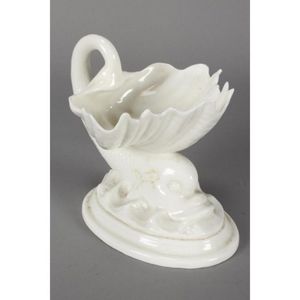
Royal Worcester Dolphin Salt Dish
Royal Worcester figural salt dish, in the form of a dolphin surmounted by a clam shell, height 11 cm

Bird-Painted Royal Worcester Sugar & Cream by W. Powell
Royal Worcester moulded tub sugar & cream, painted with bird signed W Powell

Royal Worcester Fern Leaf Jug Set
Three Royal Worcester 'Fern Leaf' pieces comprising large jug, small jug & sugar bowl

Fruit-Painted Miniature Tea Set by Royal Worcester
Royal Worcester porcelain miniature, tea set, each one beautifully painted with fruit on a wooded moss ground, signed, comprising two teapots, coffee pot, two twin handled sugar bowls, creamer, cake plate, three cups, four saucers, three smaller dishes,…

Scottie Wilson Signed Stoneware Condiment Set
Royal Worcester stoneware four piece condiment set, signed Scottie Wilson
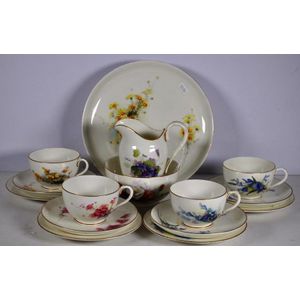
Hand-painted Royal Worcester Floral Teaset
Vintage fifteen piece Royal Worcester teaset hand painted floral decoration, marked to bases, including 4 trios, a milk jug, sugar bowl, and cake plate.

Art Deco Royal Worcester Tea Set
A Royal Worcester Art Deco tea service, includes four cups, five saucers, six cake plates, a sugar bowl & creamer
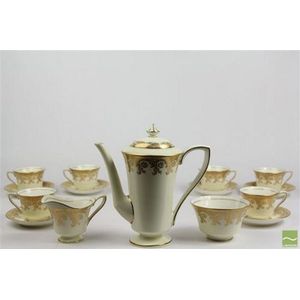
Royal Worcester Gilt Floral Tea Set for Six
Royal Worcester tea service for six in the gilt and floral design to, comprising of teapot six saucers and six cups, creamer and sugar bowl, stamped to base

Royal Worcester Porcelain Condiment Set with Reg. No. 250815
Five piece Royal Worcester porcelain condiment set, including open salt and spoon, mustard pot and pepperette. Marked to bases and Reg. No. 250815

Royal Worcester Cherub Dish and Bonzo Pepper Pots
Royal Worcester Whiteware cherub dish with Royal Worcester Bonzo pepper pot(2)

Hand-painted Royal Worcester 21-Piece Floral Teaset
Royal Worcester hand painted 21piece teaset, with signed hand painted floral decoration, comprising of 6 trios, sugar & creamer, cake plate and 2 dishes

Royal Worcester 'Royal Garden' 48-Piece Dinner Set
Forty eight piece Royal Worcester dinner set, Royal Garden' pattern. Includes 6 dinner plates, 8 coffee cups & saucers, 8 teacups & saucers, 8 side plates, & creamer & sugar.

Royal Worcester 'Princess Anne' Dinner Set for Twelve
Royal Worcester 'Princess Anne' dinner setting for twelve comprising twelve dinner plates, twelve salad plates, twelve trios (one cup missing), three tureens, one slops plate, one large platter, one smaller platter, one creamer & one sugar bowl.

Royal Worcester Hadley Ware Sugar Bowl and Milk Jug
A Royal Worcester 'Hadley Ware' sugar bowl, with matching milk jug, painted violet on ivory ground, heightened in gilt, date code 1905. Height 6 cm. Diameter 8.5 cm. (2)

Royal Worcester Blind Earl Coffee Set - 27 Pieces
Royal Worcester twenty seven piece coffee set, pattern: The Blind Earl, comprising of 12 coffee cups and saucers, coffee pot, creamer, and lidded sugar pot

Royal Worcester Dinner Service in 'Prince Regent' Pattern
An eghty one piece Royal Worcester dinner service, 1994-2009, production era, 'Prince Regent' pattern, an unused and elegant place setting for twelve with cobalt and burgundy borders with gold flowers including: dinner, entree, bread and butter plates,…

Royal Worcester Roanoke Dinner Set for Six
Royal Worcester 'Roanoke' dinner setting for six persons comprising six dinner plates, six entree plates, six cup saucer plate sets, six two handled soup bowls & saucers, six demitasse cups & saucers, six kidney shaped dishes, a sugar bowl, cream jug,…

Royal Worcester Rococo Coffee Set
A fine Royal Worcester coffee pot and two handled sugar basin in Rococo manner. 21 cm and 13 cm high.

Aesthetic Porcelain Tea Set with Lizard Handles
A Royal Worcester four piece Aesthetic movement porcelain tea set, date code: 1889, all with black ground overlaid with flowers, foliage, and butterflies, handles formed as lizards, comprising a teapot, covered sugar, creamer, and a cup and saucer.

Danish Sterling Silver Enamel Cruet & Royal Worcester Pepper Shaker
Two piece Danish sterling silver and enamel cruet stamped 'Denmark Sterling 925' to bases, together with a Royal Worcester pepper shaker

Royal Worcester Viceroy Gold Dinner Service
An Eighty nine piece Royal Worcester dinner service, 1958-2001 period of manufacture, 'Viceroy gold' pattern, the white service for eight simply embellished with a gold rim and borders, comprising: dinner, entree, side plates, sweet bowls, bouillon and…

Royal Worcester Roanoke Coffee Set with 16 Pieces
Royal Worcester coffee set Roanoke pattern, comprising coffee pot, sugar, creamer, 14 coffee cans & saucers & a sweet dish

Royal Worcester 'Woodland' Tea & Coffee Service Set
Royal Worcester 'Woodland' tea & coffee service, comprising 3 cake plates, 1 platter, 2 teapots, 18 teacups with saucers, 17 bread/butter plates, 1 coffee pot, 12 coffee cups with saucers, 2 sugar bowls, and 2 creamers

Royal Worcester Roanoke Tea Set - 3 Pieces
Royal Worcester three piece tea set. 'Roanoke' pattern, including teapot; sugar bowl & cream jug. Height 18 cm (teapot)

Royal Garden Dinner Service by Royal Crown Worcester
A Royal Crown Worcester 'Royal Garden' dinner service comprising: 9 teacups and saucers, 6 coffee cans and sauces, 6 soup cups and saucers, 6 dinner plates (10.5 inch), 6 dinner plates (8 inch), 6 side plates, 2 vegetable tureens, 1 oval serving dish, 1…

Royal Worcester Windsor Neo-Classical Dinner Service
A Royal Worcester dinner service, Windsor pattern, with neo-classical decoration. The service comprises six dinner plates (10.5 cm diameter), six entree plates (9.25 cm diameter), six dinner plates (8.00 cm diameter), six salad plates, six side plates,…

Royal Worcester Evesham Dinner Set
Royal Worcester Evesham dinner set, comprising of 2 oval casserole dishes with lids, 1 oval dish with lid, 2 round casserole dishes with lids, 1 oval serving dish, 8 dinner plates, 8 side plates, 8 entree dishes with lids,8 entree dish saucers, 8 salmon…

Hand-painted Royal Worcester Mushroom Cream & Sugar Set
Rare Royal Worcester hand painted cream & sugar, hand painted with Mushroom / Toadstool. Signed Hart. Jug 7 cm high, puce mark, 'Cortinurius', Flavelle Brothers

Royal Worcester Fruit Creamer and Sugar Bowl
A fine Royal Worcester creamer and sugar bowl, second half 20th century, both pieces with gadrooned edges in gilt and finely burnished interiors, with handpainted fruit studies, the waisted creamer with a wide pouring spout with apples and bramble berries…

Royal Worcester Tea Set with 21 Pieces
Vintage Royal Worcester tea set, comprising of cake plate, milk jug, sugar bowl, 6 plates, 6 saucers and 6 cups

Royal Worcester 'Evesham' Tableware Set - 75+ Pieces
An eight place setting of Royal Worcester 'Evesham' tableware, comprising: eight dinner plates, luncheon plates, side plates, dessert bowls, fruit dishes, ramekins; along with a three piece tea set, eight cups and saucers, sauce and gravy boats, salt and…

Royal Worcester Reticulated Tea Set, 1880
A Royal Worcester reticulated porcelain tea set, circa 1880, comprising a teapot, a cream jug, a covered sugar basin, a plate and a cup and saucer, each with honeycomb reticulation, painted in colours of turquoise, red and pink with raised jewelled…

Royal Worcester Art Nouveau Tea Set with Jewels
A rare Royal Worcester jewelled Art Nouveau part tea service, comprising two plates, milk jug and sugar bowl, painted with gilt branches with enamel coral berries

Royal Worcester Tea Set with Creamer and Sugar
A matched Royal Worcester set tea cup and saucer, creamer and sugar

Royal Worcester 'Gold Chantilly' Dinner Service
A Royal Worcester dinner service, pattern 'Gold Chantilly', consisting of - fourteen dinner plates, eighteen small soup bowls, twenty dessert bowls, two sugar bowls, twelve coffee cups and saucers, twelve tea cups and saucers, two milk jug, two meat…

Royal Worcester China Tea Set, 1937 (Damaged)
Six Royal Worcester china cups, saucers and plates, cake plate, milk jug & sugar basin, blue and gilt; c.1937. (some damage)

1879 Royal Worcester Tete-a-Tete Set with Tray
Antique Royal Worcester tete a tete comprising tea pot, sugar, creamer, two cups and saucers and tray, date cod e for 1879

Royal Worcester Porcelain Tea and Coffee Set, Fruit Still Life
A Royal Worcester porcelain tea and coffee set, comprising a tea pot, a coffee pot, a creamer and a sugar vessel, with dates ranging from 1923 to 1928 and signatures for H.H Price, W.H Austin and W. Bagnall, each painted with a still life of fruit on an…
 Loading more...
Loading more...